MQ Multiquip MVH-120GH User manual
- Category
- Engine
- Type
- User manual
This manual is also suitable for

OPERATION AND PARTS MANUAL
To find the latest revision of this
publication, visit our website at:
www.multiquip.com
SERIES
MODEL MVH-120GH
REVERSIBLE PLATE COMPACTOR
(HONDA GX160K1SM12/GX160U1SM12/
GX160U1SMX4
GASOLINE ENGINE)
THIS MANUAL MUST ACCOMPANY THE EQUIPMENT AT ALL TIMES.
Revision #3 (10/24/07)

PAGE 2 — MVH-120GH — OPERATION AND PARTS MANUAL — REV. #3 (10/24/07)
l
PROPOSITION 65 WARNING

MVH-120GH — OPERATION AND PARTS MANUAL — REV. #03 (10/24/07) — PAGE 3
NOTE PAGE

PAGE 4 — MVH-120GH — OPERATION AND PARTS MANUAL — REV. #3 (10/24/07)
l
TABLE OF CONTENTS
Proposition 65 Warning ............................................. 2
Table Of Contents ..................................................... 4
Parts Ordering Procedures ....................................... 5
Safety ..................................................................... 6-7
Rules For Safe Operation ...................................... 8-9
Specifications .......................................................... 10
General Information ................................................ 11
Multiquip MVH120GH —
Plate Compactor
Components (Plate Compactor) ............................. 12
Components (Honda Engine) ................................. 13
Inspection ........................................................... 14-15
Initial Start-Up .................................................... 16-17
Operation ................................................................ 18
Maintenance ...................................................... 19-21
Preparation For Long Term Storage ....................... 22
Troubleshooting (Engine) ................................... 23-24
Troubleshooting (Plate Compactor) ........................ 25
Explanation Of Codes In Remarks Column ............ 26
Suggested Spare Parts ........................................... 27
Name Plate And Decals ..................................... 28-29
Vibrating Plate Assembly ................................... 30-31
Body Assembly .................................................. 32-35
Vibrator Assembly .............................................. 36-39
Control Assembly ............................................... 40-43
Honda GX160 Engine
Cylinder Head Assembly ....................................44-45
Cylinder Barrel Assembly ...................................46-47
Crankcase Cover Assembly ...............................48-49
Crankshaft Assembly ......................................... 50-51
Piston Assembly .................................................52-53
Camshaft Assembly ........................................... 54-55
Recoil Starter ..................................................... 56-57
Fan Cover Assembly ..........................................58-59
Carburetor Assembly .........................................60-61
Air Cleaner Assembly.........................................62-63
Muffler Assembly ...............................................64-65
Fuel Tank Assembly ...........................................66-67
Flywheel Assembly ............................................68-69
Ignition Coil Assembly ........................................70-71
Control Assembly ...............................................72-73
Label Assembly ..................................................74-75
Tool Assembly ....................................................76-77
Terms and Conditions Of Sale — Parts .................. 78
Specification and part number
are subject to change without
notice.

MVH-120GH — OPERATION AND PARTS MANUAL — REV. #03 (10/24/07) — PAGE 5
PARTS ORDERING PROCEDURES
www.multiquip.com
Ordering parts has never been easier!
Choose from three easy options:
WE ACCEPT ALL MAJOR CREDIT CARDS!
When ordering parts, please supply:
❒❒
❒❒
❒
Dealer Account Number
❒❒
❒❒
❒
Dealer Name and Address
❒❒
❒❒
❒
Shipping Address (if different than billing address)
❒❒
❒❒
❒
Return Fax Number
❒❒
❒❒
❒
Applicable Model Number
❒❒
❒❒
❒
Quantity, Part Number and Description of Each Part
❒❒
❒❒
❒
Specify Preferred Method of Shipment:
✓
UPS/Fed Ex
✓ DHL
■
Priority One
✓
Tr uck
■
Ground
■ Next Day
■
Second/Third Day
All orders are treated as
Standard Orders
and will ship the same day if received prior
to 3PM PST.
If you have an MQ Account, to obtain a
Username and Password, E-mail us at:
To obtain an MQ Account, contact your
District Sales Manager for more information.
Order via Internet (Dealers Only):
Order parts on-line using Multiquip’s SmartEquip website!
■
View Parts Diagrams
■
Order Parts
■
Print Specification Information
Note: Discounts Are Subject To Change
Goto www.multiquip.com and click on
Order Parts
to log in and save!
Use the
internet
and qualify for a 5% Discount
on
Standard orders
for all orders which include
complete part numbers.*
Order via Fax (Dealers Only):
All customers are welcome to order parts via Fax.
Domestic (US) Customers dial:
1-800-6-PARTS-7 (800-672-7877)
Fax
your order in and qualify for a 2% Discount
on
Standard orders
for all orders which include
complete part numbers.*
Order via Phone:
Domestic (US) Dealers Call:
1-800-427-1244
Best Deal!
International Customers
should contact
their local Multiquip Representatives for
Parts Ordering information.
Non-Dealer Customers:
Contact your local Multiquip Dealer for
parts or call 800-427-1244 for help in
locating a dealer near you.
Note: Discounts Are Subject To Change
Effective:
January 1
st
, 2006

PAGE 6 — MVH-120GH — OPERATION AND PARTS MANUAL — REV. #3 (10/24/07)
l
FOR YOUR SAFETY AND SAFETY OF OTHER
S!
Safety precautions should be followed at all
times when operating this equipment. Failure
to read and understand the Safety Messages
and Operating Instructions could result in in-
jury to yourself and others.
Before using this equipment ensure that the operating indi-
vidual has read and understood all instructions in this
manual.
SAFETY MESSAGE ALERT SYMBOLS
The three Safety Messages shown below will inform you
about potential hazards that could injure you or others. The
Safety Messages specifically address the level of expo-
sure to the operator, and are preceded by one of three words:
DANGER, WARNING, or CAUTION.
CAUTION
You CAN be
INJURED
if you DO NOT follow these
directions.
WARNING
You CAN be KILLED or
SERIOUSLY INJURED
if you
DO NOT follow these directions.
DANGER
You WILL be
KILLED
or
SERIOUSLY INJURED
if you
DO NOT follow these directions.
This manual has been developed to
provide complete instructions for the
safe and efficient operation of this
equipment. Refer to the engine
manufacturer's instructions for data
relative to its safe operation.
HAZARD SYMBOLS
Potential hazards associated with the operation of this
equipment will be referenced with Hazard Symbols which
appear throughout this manual, and will be referenced in
conjunction with Safety Message Alert Symbols.
WARNING — Respiratory Hazards
ALWAYS wear approved respiratory
protection when required.
WARNING — Explosive Fuel Hazards
Fuel is extremely flammable and its
vapors can cause an explosion if ignited.
DO NOT start the engine near spilled fuel
or combustible fluids.
DO NOT fill the fuel tank while the engine
is running or hot. DO NOT overfill tank, since spilled
fuel could ignite if it comes into contact with hot engine
parts or sparks from the ignition system. Store fuel in
approved containers, in well-ventilated areas and away
from sparks and flames.
WARNING — Lethal Exhaust Gas Hazards
Engine fuel exhaust gases contain
poisonous carbon monoxide. This gas is
colorless and odorless, and can cause
death if inhaled. NEVER operate this
equipment in a confined area or enclosed
structure that does not provide ample free
flow air.
WARNING — Burn Hazards
Engine components can generate
extreme heat. To prevent burns, DO NOT
touch these areas while the engine is
running or immediately after operation.
Never operate the engine with heat
shields or heat guards removed.
SAFETY

MVH-120GH — OPERATION AND PARTS MANUAL — REV. #03 (10/24/07) — PAGE 7
CAUTION — Rotating Parts Hazards
NEVER operate equipment with covers
or guards removed. Keep fingers, hands,
hair and clothing away from all moving
parts to prevent injury.
CAUTION — Equipment Damage Hazards
Other important messages are provided throughout this
manual to help prevent damage to your equipment, other
property, or the surrounding environment.
CAUTION — Accidental Starting Hazards
ALWAYS place the equipment ON/OFF
switch in the OFF position when the
equipment is not in use.
CAUTION — Eye and Hearing Hazards
ALWAYS wear approved eye and hearing
protection.
CAUTION — Overspeed Conditions
NEVER tamper with the factory setting
of the engine governor. Personal injury
and equipment damage can result if
operating in speed ranges above the
maximum allowable.
SAFETY

PAGE 8 — MVH-120GH — OPERATION AND PARTS MANUAL — REV. #3 (10/24/07)
l
RULES FOR SAFE OPERATION
general safety
DO NOT operate or service this equipment
before reading this entire manual.
This equipment should not be operated by
persons under 18 years of age.
NEVER operate this equipment without proper protective
clothing, shatterproof glasses, steel-toed boots and other
protective devices required by the job.
NEVER operate this equipment when not
feeling well due to fatigue, illness or when
under medication.
NEVER operate this equipment under the
influence of drugs or alcohol.
NEVER disconnect any
"emergency or safety devices"
.
These devices are intended for operator safety.
Disconnection of these devices can cause severe injury,
bodily harm or even death! Disconnection of any of these
devices will void all warranties.
NEVER use accessories or attachments that are not
recommended by Multiquip for this equipment. Damage
to the equipment and/or injury to user may result.
Manufacturer does not assume responsibility for any
accident due to equipment modifications. Unauthorized
equipment modification will void all warranties.
Whenever necessary, replace nameplate, operation and
safety decals when they become difficult read.
ALWAYS check the equipment for loosened threads or
bolts before starting.
WARNING — Read This Manual
Failure to follow instructions in this manual may lead to
serious injury or even
DEATH
! This equipment is to be
operated by trained and qualified personnel only! This
equipment is for industrial use only.
NEVER touch the hot exhaust manifold,
muffler or cylinder. Allow these parts to cool
before servicing engine or equipment.
ALWAYS allow the engine to cool before
adding fuel or performing service and maintenance
functions. Contact with
hot
components can cause
serious burns.
NEVER operate this equipment in any enclosed or narrow
area where free flow of the air is restricted. The engine
of this equipment requires an
adequate free flow of cooling
air. If the air flow is restricted
it will cause serious damage
to the equipment or engine
and may cause injury to people
and property. Remember the
engine gives off DEADLY
gases.
ALWAYS refuel in a well-ventilated area, away from
sparks and open flames.
ALWAYS use extreme caution when working with
flammable liquids. When refueling, stop the engine and
allow it to cool.
DO NOT smoke around or near the
equipment. Fire or explosion could result from
fuel vapors, or if fuel is spilled on a hot engine.
NEVER operate the equipment in an
explosive atmosphere or near combustible
materials. An explosion or fire could result
causing severe
bodily harm or even death.
DO NOT top-off fuel tank. Topping-off is dangerous as it
causes fuel to spill.
ALWAYS store the equipment in a clean, dry location
out of the reach of children.
NEVER run engine without air cleaner. Severe engine
damage may occur.
NEVER leave the equipment unattended with the engine
running. Turn off engine when unattended.
CAUTION must always be observed while servicing this
equipment. Rotating parts can cause injury if contacted.

MVH-120GH — OPERATION AND PARTS MANUAL — REV. #03 (10/24/07) — PAGE 9
RULES FOR SAFE OPERATION
LOADING AND UNLOADING
Before lifting, make sure that equipment parts (hook and
vibration insulator) are not damaged and screws are not
loosened or lost.
ALWAYS make sure crane or lifting device has been
properly secured to the lifting bail (hook) of the equipment.
NEVER lift the equipment while the engine is running.
Use adequate lifting cable (wire or rope) of sufficient
strength.
Use one point suspension hook and lift straight upwards.
NEVER allow any person or animal to stand underneath
the equipment while lifting.
Do not to lift machine to unnecessary heights.
transporting
ALWAYS shutdown engine before transporting.
Tighten fuel tank cap securely and close fuel cock to
prevent fuel from spilling.
Drain fuel when transporting equipment over long
distances or bad roads.
ALWAYS tie down the equipment during transport by
securing the equipment with rope.
TYPICAL
PLATE COMPACTOR
REFUELING
MAINTENANCE SAFETY
NEVER lubricate components or attempt service on a
running machine.
ALWAYS allow the machine a proper amount of time to
cool before servicing.
Keep the equipment in proper running condition.
Fix damage to the equipment immediately and always
replace broken parts.
Dispose of hazardous waste properly. Examples of
potentially hazardous waste are used motor oil, fuel and
fuel filters.
DO NOT use food or plastic containers to dispose of
hazardous waste.
DO NOT pour waste, oil or fuel directly onto the ground,
down a drain or into any water source.
FUEL
FUEL

PAGE 10 — MVH-120GH — OPERATION AND PARTS MANUAL — REV. #3 (10/24/07)
l
MVH-120GH — SPECIFICATIONS
SNOITACIFICEPSROTCAPMOC.1ELBAT
ledoMHG021-HVM
ecroFlagufirtneC)gk053,2(.sbl002,5
snoitarbiVforebmuNnim/v000
,6
deepSgnilevarT)nim/sretem32(nim/.tf57
)WxL(eziSetalP
.ni93x7.51x32
)mm993x485(
)HxWxL(snoisnemiD
.ni93x7.
51x4.53
)mm099x993x009(
thgieWgnitarepO).gk111(.sbl742
SNOITACIFICEPSENIGNE.2ELBAT
ekaMenignEADNOH
ledoMenignE
,21MS1K061XG
,21MS1U061XG
4XMS1U061XG
epyTenignEenign
EenilosaGVHO
srednilyCfOrebmuN1
tnemecalpsiD)cc361(ni.uc9.9
tuptuOmumixaMmpr006,3/.P.H5.5
edarGliO3elbaTeeS
yt
icapaCliO)sretil6.0(stnip3.1
epyTleuFdedaelnU
yticapaCknaTleuF)sretil6.3(.tq8.3
thgieWyrD)gk51(.sbl33
dohteMg
nitratStratSlioceR

MVH-120GH — OPERATION AND PARTS MANUAL — REV. #03 (10/24/07) — PAGE 11
MVH-120GH — GENERAL INFORMATION
Definition of Plate Compactor
The Mikasa MVH-120GH is a walk-behind, reversible plate
compactor design for the compaction of sand, clay and asphalt.
This plate compactor is a powerful compacting tool capable of
applying a tremendous force in consecutive high frequency
vibrations to a soil surface. Its applications include soil compacting
for road, embankments and reservoirs as well as backfilling for
gas pipelines, water pipelines and cable installation work.
Vibratory Plates
The vibratory plates of the MVH-120GH produce low amplitude
high frequency vibrations, designed to compact granular soils.
The resulting vibrations cause forward motion. The engine and
handle are vibration-isolated from the vibrating plate. The heavier
the plate, the more compaction force it generates.
Reversible Vibratory Plates
Reversible vibratory plates have two eccentric weights that allow
a smooth transition for forward and reverse travel, plus increased
compaction force as the result of dual weights.
Due to their weight and force, reversible plates are ideal for
semi-cohesive soils.
Frequency/Speed
The compactor's vibrating plate has a frequency range between
2500 to 6000 vpm (vibrations per minute). The forward and
reverse travel speed of the compactor is approximately
75 feet/minute (23 meters/minute).
Engine
The Mikasa MVH-120GH Plate Compactor is equipped with a
Honda air-cooled, 4-cycle, gasoline engine.
Controls
Before starting the MVH-120GH Plate Compactor, identify and
understand the function of the controls and components as
indicated in Figure 1.

PAGE 12 — MVH-120GH — OPERATION AND PARTS MANUAL — REV. #3 (10/24/07)
l
MVH-120GH — COMPONENTS (PLATE COMPACTOR)
Figure 1. Compactor Controls
Figures 1 and 2 show the location of the controls, indicators and
general maintenance parts. The function of each control is
described below:
1. Breather Cap – Remove this cap to bleed (remove air)
the hydraulic system. When replacing hydraulic oil, use
"Shell Tellus #46 or equivalent".
2. Hand Grip – When operating the compactor use this hand
grip to maneuver the compactor.
3. Handle Lock – Pull handle bar downward (working
position), then pull handle lock to lock handle bar in place.
4. Vibration Case Oil Level Check Plug – Remove this plug
to check the vibration case oil. Oil level should be all the
way up to the filler port. When replacing vibration case oil,
use 10W-30 engine oil.
5. Handle Bar (working position) – When operating the
compactor, this handle is to be in the downward position.
6. Handle Bar (stored position) – When the compactor is
to be
stored
, move the handle bar to the upright position.
7. Gasoline Engine – This plate compactor uses a HONDA
GX160 engine. Refer to the HONDA owner's manual for
engine information.
8. Belt Cover – Remove this cover to gain access to the V-belts.
NEVER run the compactor without the V-belt cover. If the V-
belt cover is not installed, your hand may get caught between
the V-belt and clutch, thus causing serious injury and bodily
harm.
9. Vibration Case – Encloses the eccentric gears and counter
weights.
10. Forward & Reverse Lever –
Push
the lever forward, the
compactor will move in a forward direction.
Pull
the lever
backwards, the compactor will move in backwards direction.
Placing the lever in the middle (midway) will cause the
compactor not to move (neutral).
11. Throttle Control – Move the throttle lever to the
rabbit
position for full throttle (max RPMs). For engine idle, move
the throttle lever to the
turtle
position.
9
8
7
5
REVERSE
NEUTRAL
FORWARD
10
6
11
1
2
3
4

MVH-120GH — OPERATION AND PARTS MANUAL — REV. #03 (10/24/07) — PAGE 13
MVH-120GH — COMPONENTS (HONDA GX160 ENGINE)
Figure 2. Engine Controls & Components
1. Fuel Filler Cap – Remove this cap to add unleaded
gasoline to the fuel tank. Make sure cap is tighten securely.
DO NOT over fill.
2. Throttle Lever – Used to adjust engine speed (fast-slow).
3. Recoil Starter (pull rope) – Type of engine starting method.
Alternate type would be electric start (ignition key).
4. Starter Grip – Grip this handle to start engine. See engine
starting section of this manual.
5. Fuel Valve Lever – OPEN to let fuel flow, CLOSE to stop
the flow of fuel.
6. Choke Lever – Used in the starting of a cold engine, or in
cold weather conditions. The choke enriches the fuel
mixture.
7. Air Cleaner – Prevents dirt and other debris from entering
the fuel system. Remove wing-nut on top of air filter
cannister to gain access to filter element.
8. Spark Plug – Provides spark to the ignition system. Set
spark plug gap to 0.6 - 0.7 mm (0.028 - 0.031 inch). Clean
spark plug once a week.
9. Muffler – Used to reduce noise and emissions.
10. Fuel Tank – Holds 3.6 liters (approximately 1 gallon) of
unleaded gasoline.

PAGE 14 — MVH-120GH — OPERATION AND PARTS MANUAL — REV. #3 (10/24/07)
l
MVH-120GH — INSPECTION
Before Starting
1. Read safety instructions at the beginning of manual.
2. Clean the compactor, removing dirt and dust. Particularly, the
bottom of the plate, engine cooling air inlet, carburetor and
air cleaner.
3. Check the air filter for dirt and dust. If the air filter is dirty, blow
through the air filter cartridge from the inside, moving a jet of
dry compressed air up and down until all dust is removed.
Otherwise replace air filter with a new one.
4. Check carburetor for external dirt and dust. Clean with dry
compressed air.
5. Check fastening nuts and bolts for tightness. Loosened
screws or bolts due to vibration, could lead to unexpected
accident.
Engine Oil Check
1. To check the engine oil level, place the plate compactor on
secure level ground with the engine stopped.
2. Remove the filler cap/dipstick from the engine oil filler hole
(Figure 3) and wipe it clean.
Figure 3. Engine Oil Dipstick
3. Insert and remove the dipstick without screwing it into the filler
neck. Check the oil level shown on the dipstick.
4. If the oil level is low (Figure 4), fill to the edge of the oil filler
hole with the recommended oil type (Table 3). Maximum oil
capacity is 400 cc.
Figure 4. Engine Oil Dipstick
The Oil Alert system will automatically stop
the engine before the engine falls below safe
limits. Always be sure to check the engine
oil level prior to starting the engine.
Vibrator Oil Check
1. Place the MVH-120GH horizontally on a flat surface.
2. Check vibrator oil level by removing bolt (vibrator oil gauge)
as shown in Figure 5. Use a 14 mm wrench to remove bolt. The
vibrator oil level should be maintained between the two mark-
ings as shown in Figure 5. If oil is required, replace using SAE
10W-30.
Figure 5. Vibrator Oil Gauge
Gasoline Check
1. Remove the gasoline cap located on top of fuel tank.
2. Visually inspect to see if fuel level is low. If fuel is low, replenish
with unleaded fuel.
3. When refueling, be sure to use a strainer for filtration. DO
NOT top-off fuel. Wipe up any spilled fuel.
ENGINE OIL
DIPSTICK
ENGINE OIL
FILLER HOLE
UPPER LIMIT
LOWER LIMIT
OIL
OIL GAUGE
MAINTAIN OIL
LEVEL BETWEEN
LINES
epyTliO.3elbaT
nosaeS erutarepmeT epyTliO
remmuS rehgiHroC°52 03-W01EAS
llaF/gnirpS C°01~C°52 02/03-W01EAS
retniW rewoLroC°0 01-W01EAS

MVH-120GH — OPERATION AND PARTS MANUAL — REV. #03 (10/24/07) — PAGE 15
2. The V-belt tension is proper if the V-belt bends 10 to 15 mm
(Figure 9) when depressed with finger at midway between
the clutch and vibration pulley shafts.
Vibrator Oil Check
1. With handle bar positioned vertically (storage position),
remove the breather cap (Figure 6) from the breather plug.
2. Use a 24 mm wrench and remove breather plug (Figure 6).
Visually check to see if hydraulic oil comes up to the oil level
line that is etched on the back side of the handle.
MVH-120GH — INSPECTION
OIL LEVEL
CAP
BREATHER
PLUG
HAND PUMP
Figure 6. Vibrator Oil Gauge
2. If the hydraulic oil level is low, replace with "Shell Tellus"
oil #46 or equivalent.
1. To check the V-belt tension (Figure 8 ), remove
upper
belt
cover.
CLUTCH
PULLEY
VIBRATOR
PULLEY
V-Belt Check
Figure 7. V-Belt Hazard
Figure 8. V-Belt Location
3. A loose V-belt will decrease the power transmission output,
causing reduced compaction and premature wear of the
belt. V-belt in use is RPF-3320 (A-32 is also usable).
4. If the V-belt becomes worn or loose, replace it by using V-
belt part number RPF-3320 or A-32.
Figure 9. V-Belt Tension
CAUTION
NEVER attempt to check the V-belt with the engine running.
Severe injury can occur of your hand (Figure 7) gets caught
between the V-belt and the clutch. Always use safety gloves.

PAGE 16 — MVH-120GH — OPERATION AND PARTS MANUAL — REV. #3 (10/24/07)
l
D
1. Place the
fuel valve lever
(Figure 10) in the "ON" position.
Figure 10. Fuel Valve Lever
2. Place the
Engine ON/OFF switch
(Figure 11) in the "ON"
position.
Figure 11. Engine ON/Off Switch
3. Place the
Choke Lever
(Figure 12) in the "OPEN" position.
Nnnn
The CLOSED position of the choke lever
enriches the fuel mixture for starting a COLD
engine. The OPEN position provides the correct
fuel mixture for normal operation after starting,
and for restarting a warm engine.
Figure 12. Choke Lever
4. Place the
throttle lever
(Figure 13) halfway between
fast
and
slow
.
Figure 13. Engine Throttle Lever
MVH-120GH — INITIAL START-UP
Some compactor units may be equipped with
a throttle lever (Figure 13A) that is located in
the vicinity of the hydraulic pump. This throttle
lever is connected to the engine throttle
linkage.
Figure 13A. Engine Throttle Lever
DO NOT attempt to run the compactor until the Safety and
Initial Start-up sections have been read,
CAUTION

MVH-120GH — OPERATION AND PARTS MANUAL — REV. #03 (10/24/07) — PAGE 17
MVH-120GH — INITIAL START-UP
5. Grasp the starter grip (Figure 14) and slowly pull it out. The
resistance becomes the hardest at a certain position, corre-
sponding the compression point. Rewind the rope a little from
that point and pull out sharply.
Figure 14. Starter Grip
6. If the engine has started, slowly return the choke lever
(Figure 12) to the
CLOSED
position. If the engine has not
started, repeat steps 1 through 5.
7. Before the compactor is put into operation, run the engine for
3 to 5 minutes.
8. Check for abnormal engine noises or fuel leaks.
Stopping the Engine
1. Place the
throttle lever
(Figure 13 or 13A) in
slow
position,
and listen for the engine speed to decrease.
2. Place the
engine ON/OFF switch
(Figure 11) in the
"OFF"
position.
3. Place the
fuel valve lever
(Figure 10) in the
"OFF"
position.
CAUTION
z
DO NOT pull the starter rope all the way to the end.
z
DO NOT release the starter rope after pulling. Allow
it to rewind as soon as possible.
CAUTION
NEVER stop the engine suddenly while working at
high speeds.

PAGE 18 — MVH-120GH — OPERATION AND PARTS MANUAL — REV. #3 (10/24/07)
l
MVH-120GH — OPERATION
Operation
1. Grasp the compactor's hand grip (Figure 15), and move
the engine throttle lever quickly from the
turtle
position
(idle) to the
rabbit position
(full throttle)
position.
2. Run the compactor at full throttle (3,600 RPM's), the
centrifugal clutch will automatically engage when the
engine speed reaches 2,300 RPM.
Always move the throttle lever quickly without
hesitation, because increasing the engine
speed slowly causes the clutch to slip.
3. To make the compactor move in the forward direction
push the travel lever (Figure 15) forward.
Figure 15. Direction Lever
4. To make the compactor move in the reverse direction pull
the travel lever (Figure 15) backwards.
5. Firmly grasp the compactor's hand grip, the compactor
will begin moving in the desired position when the
direction lever has been placed in the desired position.
6. Slowly walk behind the compactor and be on the lookout
for any large objects or foreign matter that might cause
damage to the compactor or bodily injury.
7. Compactor traveling speed may drop on soils which
contain clay, however there may be cases where travel-
ing speed drops because the compaction plate does not
leave the ground surface easily due to the composition
of the soil. To rectify this problem do the following:
z
Check the bottom plate to see if clay or
similar material has been lodged in the plate
mechanism. If so, wash with water and
remove.
z
Keep in mind that the compactor does not
work as efficiently on clay or soils that have
a high moisture content level.
z
If the soil has a high moisture level, dry soil
to appropriate moisture content level or carry
out compaction twice.
Make sure to follow all safety rules referenced in the
safety section of this manual before operating compac-
tor. Keep work area clear of debris and other objects that
could cause damage to the compactor or bodily injury.
CAUTION
z
Moving the direction lever back and forth a few
times after the engine has been turned off, will
cause the lever to be locked in the forward position.
z
DO NOT try to operate lever forcibly. The direction
lever will operate normally when the engine is
started and the compactor is in action.
CAUTION

MVH-120GH — OPERATION AND PARTS MANUAL — REV. #03 (10/24/07) — PAGE 19
Inspection and Maintenance Service Tables.
1. To make sure your plate compactor is always in good
working condition before using, carry out the maintenance
inspection in accordance with Tables 4 through 6.
Daily Service
z
Check for leakage of fuel or oil.
z
Check for loose screws including tightness. See Table 6
below (tightening torque), for retightening:
z
Remove soil and clean the bottom of compaction plate.
z
Check hydraulic pump, piping and hose for any leakage.
A loosened hydraulic hose can be a cause for leakage.
Check hydraulic hose connections with wrench applied
for tightness.
z
Check engine oil.
MVH-120GH — MAINTENANCE
KCEHCENIGNE.5ELBAT
)launaMenignEetarapesees,sliatedroF(
metI noitarepOfosruoH
leufroliofoegakaeL )yadyreve(sruoh8yrevE
sdaerhtgninetsaffossenthgiT )yadyreve(sruoh8yrevE
dnakcehclioenignE
tnemhsinelper
yreve(sruoh8yrevE
.xamdeificepsothsinelpeR()yad
)level
tnemhsinelperlioenignE
001yreveneht,sruoh02tsriftA
sruoh
gninaelcrenaelcriA sruoh05yrevE
NOITCEPSNIENIHCAM.4ELBAT
metI noitarepOfosruoH
kcehcgnitratS )yadyreve(sruoh8yrevE
swercstsolrodenesooL )yadyreve(sruoh8yrevE
strapdegamaD )yadyreve(sruoh8yrevE
gnillortnocfonoitcnuF
trapmetsys
)yadyreve(sruoh8yrevE
kaelmetsysciluardyH sruoh001yrevE
kcehcliorotarbiV sruoh003yrevE
tnemecalperliorotarbiV sruoh001yrevE
kcehcliociluardyH .srh0001yrevenehtsruoh002yrevE
kcehc)hctulc(tleb-V ruoh002yrevE
.6ELBAT
retemaiD)mc/gk.ni(EUQROTGNINETHGIT
lairetaM
mm6 mm8 mm01 mm21 mm41 mm61 mm81 mm02
T4 07 051 003 005 057 001,1 004,1 000,2
T8-6 001 052 005 008 003,1 000,2 007,2 008,3
T11 051 004 008 002,1 000,2 009,2 002,4 006,5
* )mm01(007~056)mm8(053~003)mm6(001
)munimulafositrap-retnuocesacnI(*
)dednahthgirllaeraenihcamsihthtiwesunisdaerhT(
,tlobhcaenodekramsilairetamfoytilauqdnalairetaM
.wercsdna
Inspection and other services should
always
be carried
out on solid and level ground with the engine shut down.
CAUTION
These inspection intervals are for operation under normal
conditions. Adjust your inspection intervals based on the
number of hours plate compactor is in use, and particular
working conditions.
CAUTION
Fuel piping and connections should be replaced every 2
years.
CAUTION

PAGE 20 — MVH-120GH — OPERATION AND PARTS MANUAL — REV. #3 (10/24/07)
l
Engine Oil Replacement:
1. Replace engine oil, first in 20 hours of operation and every
100 hours afterwards.
2. Oil may be drained more easily when it is warm after
operation (For more details, see separate HONDA Owner's
Manual).
Air Filter
1. The air filter element should be cleaned because a clogged
air cleaner can cause poor engine starting, lack of power
and shorten engine life substantially.
2. To clean or replace air filter, loosen the wing nut on the air
filter housing (Figure 16). Remove the cover and take out
air filter cartridge. If only cleaning of the air filter is desired,
blow through the air filter cartridge from the inside, moving a
jet of dry compressed air up and down until all dust is
removed.
z
Reinstalling the V-belt
Engage V-belt to lower vibrator pulley and push the V-belt to left
side of upper clutch. In the same manner as in removal, rotate
offset wrench clockwise so that the V-belt goes back on.
z
Replacing the V-belt
Remove the upper and lower belt covers. Engage an offset
wrench (13 mm) or the like to vibrator pulley (lower) fastening
bolt. Engage waste cloth or the like at midway of V-belt on the left
side and while pulling it back strongly, rotate the offset wrench
clockwise so that the V-belt will come off.
z
Checking Clutch
Check the clutch simultaneously with V-belt checking. With belt
removed, visually check outer drum of the clutch for seizure and
"V" groove for wear or damage. Clean the "V" groove as necessary.
Regularly check the lining or shoe for wear. If the shoe is worn,
power transmission becomes deficient and slipping will result.
MVH-120GH — MAINTENANCE
Vibrator Oil Level Check
1. In every 300 hours of operation, with the machine positioned
horizontally, remove vibrator oil level check plug (Figure 5)
off vibrator (14 mm wrench) and see if oil is up to filler port.
Be sure to clean area around check hole to prevent dirt and
dust from entering.
2. In every 300 hours of operation, replace oil (capacity 400 cc).
For draining oil through level check hole, have the machine
inclined with a sleeper or the like placed under the
compaction plate on opposite side.
*
Use engine oil 10W-30 for this lubrication.
Checking and Replacing the V-Belt and Clutch
1. After 200 hours of operation, remove the upper belt cover to
check the V-belt tension. Tension is proper if the belt bends
about 10 mm when depressed strongly with finger between
shafts. Loose or worn V-belts reduce power transmission
efficiency, causing weak compaction and reducing the life
of the belt itself.
Figure 16. Air Filter
CAUTION
NEVER attempt to check the V-belt with the engine run-
ning. Severe injury can occur if your hand gets caught
between the V-belt and the clutch. Always use safety
gloves.
Whenever the compactor's vibration becomes weak or lost
during normal operation regardless of operation hours,
check the V-belt and clutch immediately.
CAUTION
Always clean the area around the vibrator oil level check
hole before removing oil check plug. This will prevent dirt
and debris from entering the system.
CAUTION
Page is loading ...
Page is loading ...
Page is loading ...
Page is loading ...
Page is loading ...
Page is loading ...
Page is loading ...
Page is loading ...
Page is loading ...
Page is loading ...
Page is loading ...
Page is loading ...
Page is loading ...
Page is loading ...
Page is loading ...
Page is loading ...
Page is loading ...
Page is loading ...
Page is loading ...
Page is loading ...
Page is loading ...
Page is loading ...
Page is loading ...
Page is loading ...
Page is loading ...
Page is loading ...
Page is loading ...
Page is loading ...
Page is loading ...
Page is loading ...
Page is loading ...
Page is loading ...
Page is loading ...
Page is loading ...
Page is loading ...
Page is loading ...
Page is loading ...
Page is loading ...
Page is loading ...
Page is loading ...
Page is loading ...
Page is loading ...
Page is loading ...
Page is loading ...
Page is loading ...
Page is loading ...
Page is loading ...
Page is loading ...
Page is loading ...
Page is loading ...
Page is loading ...
Page is loading ...
Page is loading ...
Page is loading ...
Page is loading ...
Page is loading ...
Page is loading ...
Page is loading ...
Page is loading ...
Page is loading ...
-
 1
1
-
 2
2
-
 3
3
-
 4
4
-
 5
5
-
 6
6
-
 7
7
-
 8
8
-
 9
9
-
 10
10
-
 11
11
-
 12
12
-
 13
13
-
 14
14
-
 15
15
-
 16
16
-
 17
17
-
 18
18
-
 19
19
-
 20
20
-
 21
21
-
 22
22
-
 23
23
-
 24
24
-
 25
25
-
 26
26
-
 27
27
-
 28
28
-
 29
29
-
 30
30
-
 31
31
-
 32
32
-
 33
33
-
 34
34
-
 35
35
-
 36
36
-
 37
37
-
 38
38
-
 39
39
-
 40
40
-
 41
41
-
 42
42
-
 43
43
-
 44
44
-
 45
45
-
 46
46
-
 47
47
-
 48
48
-
 49
49
-
 50
50
-
 51
51
-
 52
52
-
 53
53
-
 54
54
-
 55
55
-
 56
56
-
 57
57
-
 58
58
-
 59
59
-
 60
60
-
 61
61
-
 62
62
-
 63
63
-
 64
64
-
 65
65
-
 66
66
-
 67
67
-
 68
68
-
 69
69
-
 70
70
-
 71
71
-
 72
72
-
 73
73
-
 74
74
-
 75
75
-
 76
76
-
 77
77
-
 78
78
-
 79
79
-
 80
80
MQ Multiquip MVH-120GH User manual
- Category
- Engine
- Type
- User manual
- This manual is also suitable for
Ask a question and I''ll find the answer in the document
Finding information in a document is now easier with AI
Related papers
-
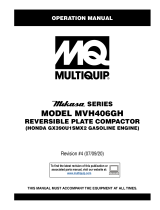 MQ Multiquip MVH406GH Operating instructions
MQ Multiquip MVH406GH Operating instructions
-
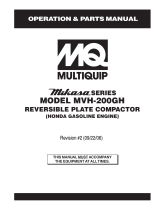 MQ Multiquip MVH200GH User manual
MQ Multiquip MVH200GH User manual
-
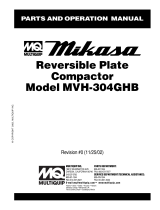 MQ Multiquip MVH304GHB User manual
MQ Multiquip MVH304GHB User manual
-
MQ Multiquip MVH402GHB User manual
-
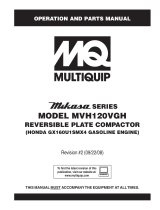 MQ Multiquip MVH120VGH Operating instructions
MQ Multiquip MVH120VGH Operating instructions
-
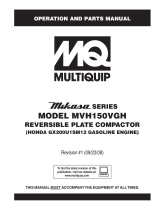 MQ Multiquip MVH150VGH Operating instructions
MQ Multiquip MVH150VGH Operating instructions
-
MQ Multiquip LT6D Specification
-
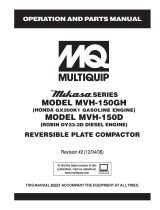 MQ Multiquip MVH-150GH User manual
MQ Multiquip MVH-150GH User manual
-
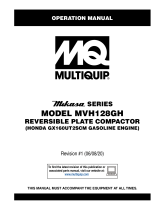 MQ Multiquip MVH128GH Operating instructions
MQ Multiquip MVH128GH Operating instructions
-
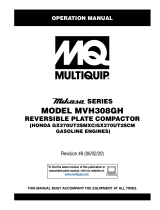 MQ Multiquip MVH308GH Operating instructions
MQ Multiquip MVH308GH Operating instructions
Other documents
-
 MULTIQUIP MVH408GH User manual
MULTIQUIP MVH408GH User manual
-
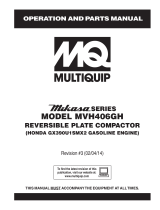 MULTIQUIP MVH406GH User manual
MULTIQUIP MVH406GH User manual
-
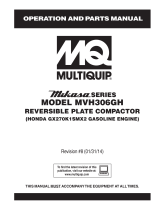 MULTIQUIP MVH306GH User manual
MULTIQUIP MVH306GH User manual
-
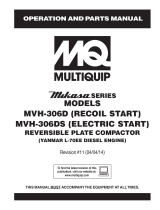 MULTIQUIP MVH-306D User manual
MULTIQUIP MVH-306D User manual
-
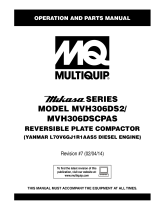 Multi Tech Equipment MVH306DS2 User manual
Multi Tech Equipment MVH306DS2 User manual
-
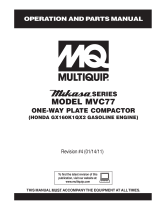 MULTIQUIP ONE-WAY PLATE COMPACTOR User manual
MULTIQUIP ONE-WAY PLATE COMPACTOR User manual
-
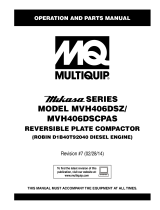 MULTIQUIP MVH406DSCPAS User manual
MULTIQUIP MVH406DSCPAS User manual
-
Alarm Lock LEVER CONNECTOR REPLACEMENT KIT Addendum User manual
-
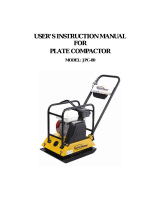 Northern Industrial JPC-80 User Instruction Manual
Northern Industrial JPC-80 User Instruction Manual
-
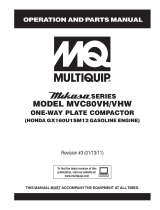 MULTIQUIP MVC80VH/VHW User manual
MULTIQUIP MVC80VH/VHW User manual
































































































